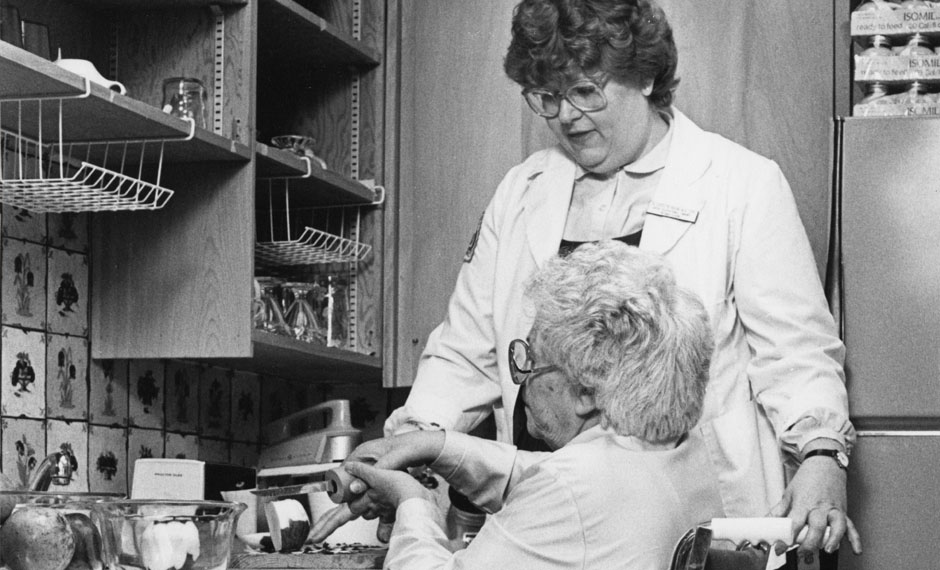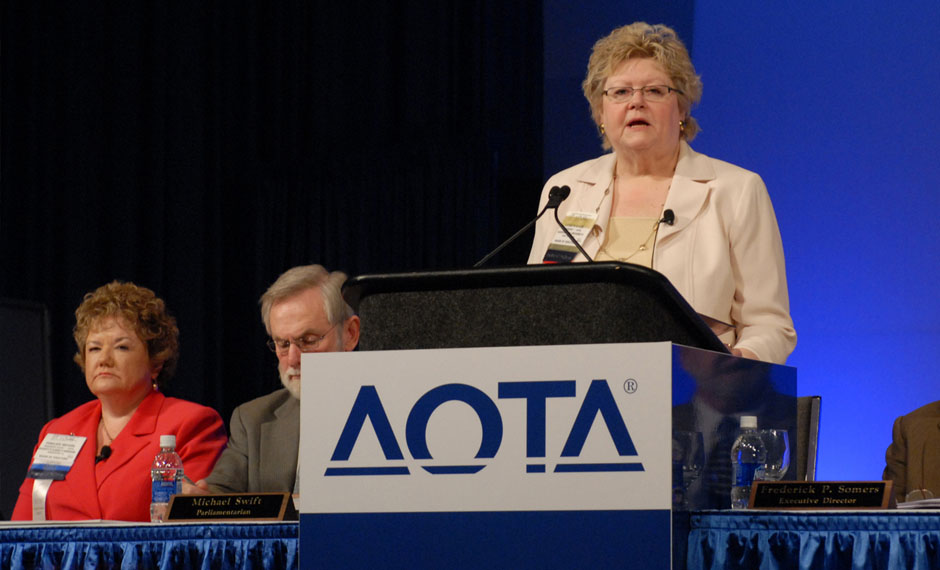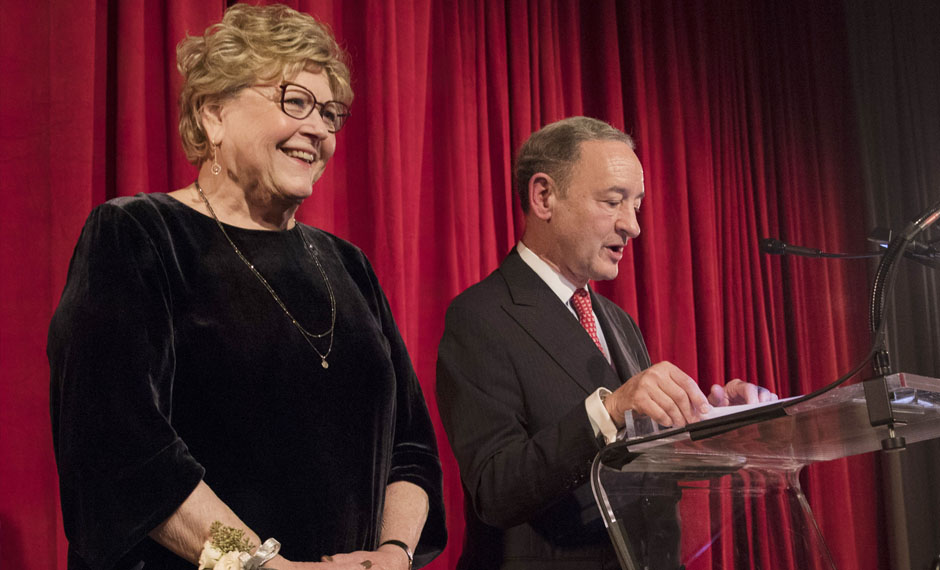Rehabilitation and Participation Science
Program in Occupational Therapy
by Michele Berhorst • March 12, 2019

As director of occupational therapy at the Irene Walter Johnson Institute of Rehabilitation, M. Carolyn Baum, PhD, OTR, FAOTA (standing), and her colleagues identified needs in the community and worked to develop programs to serve them.
On June 30, 2019, M. Carolyn Baum, PhD, OTR/L, FAOTA, will be stepping down as Elias Michael Director of the Program in Occupational Therapy after 31 years. In a career that spans more than 50 years, Baum has helped develop and direct the science-driven practice of occupational therapy to promote participation, wellness and quality of life. She has contributed to all aspects of the profession including research, theory, policy, practice and education. In 2017, Baum was named one of AOTA’s 100 influential people who has shaped the history of occupational therapy itself. With all that she has accomplished, Baum still feels she has more work to do.
Setting a course
Baum was born in Chicago in 1943 to Gibson Henry Manville, a Pullman train conductor, and Nell Laverne Curry, a teacher. She grew up in the small farming community of Winchester, Kan., which had a population of just 400. Baum was a member of a class of 18 students who went from first grade to high school together. She was involved in 4-H Club, enjoyed cooking and sewing, and was awarded a Betty Crocker Homemaker of Tomorrow award. She was all set to be the homemaker her parents wanted her to be when the course of her life changed during a visit to her cousin in Tacoma, Wash.
“She was the assistant director of special education for the Tacoma public school system, which was one of the first school districts in the country that mainstreamed children with disabilities into regular classrooms,” Baum explains. “During the course of my week-long visit, my cousin encouraged me to observe the occupational therapist who was working with these children in a resource room designed to help them succeed in the classroom. I knew then I wanted to be an occupational therapist.”
To accomplish this goal, Baum had to convince her parents that she would be a “better” homemaker if she had a degree in home economics. With their consent, she enrolled in Kanas State University. After adjusting to the rigors of higher education during her freshman year, Baum transferred to the University of Kansas and switched her major. In 1966, she earned her bachelor’s degree in occupational therapy. She was on her way.
Forging ahead
Baum’s first clinical position was at the University of Kansas (KU) Medical Center in Kansas City in 1966. In the 18 months she was there, Baum started a cardiac rehabilitation program with a nurse and presented her first paper. She left KU to start a rehabilitation occupational therapy program at the Research Medical Center in Kansas City. After six months there, the occupational therapy director left and convinced the administration that Baum could replace her. She took weekly courses in management training through the American Management Association to strengthen her hospital administration skills. Eventually, she went on to become the director of physical medicine and rehabilitation managing physicians and occupational, physical and speech therapists in 1973.
It was during this time that Baum became actively involved in the American Occupational Therapy Association (AOTA). She caught the attention of Florence Cromwell and Wilma West, both noted leaders in the profession, who served as her mentors. She also caught the attention of AOTA president Jerry Johnson and Elias Michael Director of the Program in Occupational Therapy at Washington University. Johnson recruited Baum to run the occupational therapy program at the Irene Walter Johnson (IWJ) Rehabilitation Institute in 1976.
It did not take Baum long to help position IWJ in the forefront of providing occupational therapy services to the community at large. In her first two years as director of occupational therapy, Baum increased the staff from five to 14 and expanded service programs in neurology, general medicine, hand rehabilitation, nephrology, rheumatology and pediatrics. It was also a time of personal growth—Baum earned a master’s degree in health management from Webster University in St. Louis in 1979. She expanded her leadership experience further by serving as AOTA president from 1982-1983 and becoming president of the National Board of Certification of Occupational Therapy (NBCOT) in 1986. Above all this, Baum saw the need to incorporate science into the profession itself.
“At this point in time, there were very few occupational therapy scientists. I started to connect with neurologists and plastic surgeons and encouraged pilot studies to show how occupational therapy could help physicians manage their complex patients,” Baum says. Her collaborative efforts led Sven Eliasson, MD, PhD, to encourage her to apply for the Elias Michael Director position when Mary Ann Boyle, who succeeded Johnson, resigned in 1987. It was a seemingly impossible task; the program was slated for closure.

Baum (standing) was named as one of AOTA’s 100 Most Influential People who have shaped the profession’s 100-year history in celebration of occupational therapy’s Centennial in 2017.
Rising to prominence
When Baum began her tenure as Elias Michael Director in 1988, she knew she had to turn the Program into an academic discipline for it to survive. She hired scientists Dorothy Edwards, PhD, and Jan Duchek, PhD, and they mentored faculty and students in how to apply science to everyday problems in living. In 1993, she brought in colleague Sue Baptiste to help redesign and modernize the curriculum to address the occupational needs of society. That same year, Baum earned her doctorate in social work with a concentration in social policy and aging from the Brown School at Washington University. Leonard Berg, PhD, known for his breakthrough research on Alzheimer’s, served as her mentor and friend during this time of change, renewal and growth.
Throughout the 1990s, Baum contributed to the profession by developing the Person-Environment-Occupation-Performance (PEOP) model, initially with her colleague Charles Christiansen, and more recently with Julie Bass, and led the development of functional assessments based in everyday living (the Activity Card Sort, the Kitchen Task Assessment, the Functional Behavior Profile and the Executive Function Performance Test). These are widely used by practitioners all over the world. She was also involved in two major rehabilitation policy initiatives by serving on the National Institutes of Health (NIH) committee that wrote the rehabilitation plan for Congress that implemented the National Center for Medical Rehabilitation Research and on the Institute of Medicine committee that wrote the report “Enabling America for Congress.”
In the next decade, Baum rose to prominence as a leader and scientist. She served as AOTA president again from 2003-2007 and was inducted into the American Occupational Therapy Foundation’s (AOTF’s) Academy of Research in 2005. In 2009, she received the AOTA and AOTF President’s Commendation Award in honor of Wilma West, her former mentor. She was inducted into the Academy of Science in St. Louis in 2010 and served as chair of the AOTF Research Commission from 2011-2016.
After a series of pilot grants, Baum received major funding from the James S. McDonnell Foundation for her project titled “Linking Neuroscience to Everyday Life.” She brought together 22 scientists from neurology, neurobiology, neuroradiology, philosophy, psychology, occupational therapy, movement science and communication science to form the Cognitive Rehabilitation Research Group (CRRG) with the goal of translating knowledge from neuroscience into treatment programs for those with stroke. Susan Fitzpatrick, PhD, president of the McDonnell Foundation, recalls how from the start, Baum needed her colleagues to see beyond just the medical perspective.
“With the initial planning grant, Carolyn had high-quality videos made of people recovering from different cognitive deficits as result of brain injury—for example, left hemisphere stroke, right hemisphere stroke—just engaging in everyday activity, whether it was trying to cook something or look up a number in the phone book,” Fitzpatrick says. “It allowed the neuroscientists and psychologists to see in a neutral way somebody doing something naturally, not in a laboratory. To think about not just how do people look in a clinical setting, or how do people look on some of the instruments that we may use to measure or monitor function, but how are they actually performing in their everyday life?”
Helene Polatajko, PhD, an internationally respected occupational therapy scholar from the University of Toronto, was part of the Canadian cohort. “Carolyn’s ability to build bridges to bring people together is what made this project so groundbreaking. She was able to get the psychologists and the occupational scientists to start talking to each other and understanding each other better,” Polatajko recalls. “The project brought together Canadians and Americans, and we have extremely different health-care systems and ways we improve the lives of people with disabilities.”
By the 2010s, Baum had not only reformed the Program into an academic discipline, but she had built it into a research enterprise. She had set a vigorous pace for advancing the science to develop and improve occupational therapy education and rehabilitation practices at the School of Medicine. Baum served as mentor to a highly productive faculty that includes academicians and early- and mid-career scientists to generate and disseminate knowledge that supports evidence-based practice.
Christine Berg, PhD, OTR/L, FAOTA, has worked with Baum during her entire tenure as director and has served on various curriculum committees over the years. “Under Carolyn’s leadership and guidance, our innovative curriculum continually evolved through the influence of her national and international experiences, her research and scholarship, her policy knowledge about the ever-changing health-care landscape, and her vision and conceptualization of what participation science could bring to our program and to the profession at large,” Berg shares.
Early career scientist Kerri Morgan, PhD, OTR/L, ATP, values the mentorship Baum has provided since joining the faculty in 2003. “Carolyn’s guidance and mentorship were critical in helping me reach my professional research goals. She supported me when I returned to school for my PhD. Afterwards, she assisted me with the transition from clinician track to research tenure track faculty,” Morgan says. “Carolyn has had a strong influence on the development of my work and ideas and the growth of my professional network by providing the resources and support for me to be successful. She also created an environment that allowed me not only to pursue my professional goals, but also my personal goals including competing in the Paralympic Games.”
Expanding science
Although she is stepping down, Baum makes it clear she is “not retiring.” Instead, she will focus on her research, which centers on enabling older adults to live independently. Currently, she is working on additional measurement work to establish functional cognition as a central element that must be addressed by occupational therapy to help people live lives when mild cognitive impairment is interfering with their ability to engage with family, work and community activities. She is collaborating with fellow scientists Joy Hammel, PhD, from the University of Illinois at Chicago, and Elizabeth Skidmore, PhD, from the University of Pittsburgh, on grants to improve community participation after stroke. Hammel and Baum take an intervention approach that uses self-management training and social learning to give stroke survivors the knowledge and confidence to participate individually in meaningful activities and develop a strong network of social support. Skidmore’s approach uses guided skill development to teach people strategies to identify and navigate barriers to community participation.
“Both approaches are community focused, individually tailored and culturally responsive, which makes them adaptable for people with varying abilities and resources,” Baum says. “Our work will examine whether the combination of these approaches improves the community participation among people with stroke-related disability.”
Skidmore is looking forward to this and future work with Baum, whom Skidmore considers “an outstanding advocate” in ensuring that national scientific agencies recognize the value of investing in occupational therapy and rehabilitation science. “She has educated people and organizations within the field and outside the field on the importance of investing in our profession. Her involvement with advisory boards and councils of multiple federal agencies has been critical to increasing awareness of our profession’s contributions and capacity for scientific advancement.” Skidmore shares. “Most scientists like me make a dent in an area of inquiry; Carolyn has created areas for multiple scientists to make dents around multiple areas of inquiry. She serves and will continue to serve as the conduit for the broader mission of occupational therapy beyond her own research.”

Chancellor Mark S. Wrighton (right) presented Baum with Washington University's Distinguished Faculty Award at the Founders Day dinner and ceremony on Oct. 28, 2017. The award recognizes outstanding commitment to the intellectual and personal development of students.
A lasting legacy
In 2017, the occupational therapy profession celebrated its 100th anniversary, and Baum has been a thought leader for more than half of those years. Throughout her career, she remained committed to making the profession an integral and vital part of the health-care system to improve people’s lives through meaningful participation. Her PEOP model is part of the occupational therapy vernacular, and her clinical assessments are standard tools in the practitioner’s toolbox. Although Baum is world renowned for her contributions to occupational therapy science, her colleagues feel her legacy goes much deeper than that.
“Carolyn makes people think, she makes people connect, and she makes people want to connect. She identifies the barrier, and she facilitates making that barrier go away. She's a true visionary, and she works tirelessly to make her visions a reality,” Polatajko says.
Skidmore agrees. “Carolyn is one of the titans of our profession. These titans have all made contributions in different ways, and they led us through the toughest periods of the profession’s history including major expansion in our practice, education and science, as well as, great periods of vulnerability. However, the opportunities for the profession are greater now than they have ever been. I don’t know if we’ll ever be able to truly assess the ripple effects of the impact that Carolyn has had on our profession and our various missions,” Skidmore says.
We welcome inquiries from prospective students, potential collaborators, community partners, alumni and others who want to connect with us. Please complete the form below to begin the conversation.
Schedule an Info Session
We are excited that you are considering applying to the Program in Occupational Therapy at Washington University. Please join us for a Zoom Information Session for either our entry-level MSOT or OTD degrees or our online Post-Professional OTD. Current faculty members will discuss the degree program and answer any question you may have. We are offering these sessions on the following days and times. The content is the same for each one, so you only need to sign up for one.
Upcoming ENTRY-LEVEL Degree ZOOM Info sessions:
Schedule an Entry-Level Info Session
Upcoming PP-OTD Degree ZOOM Info session: